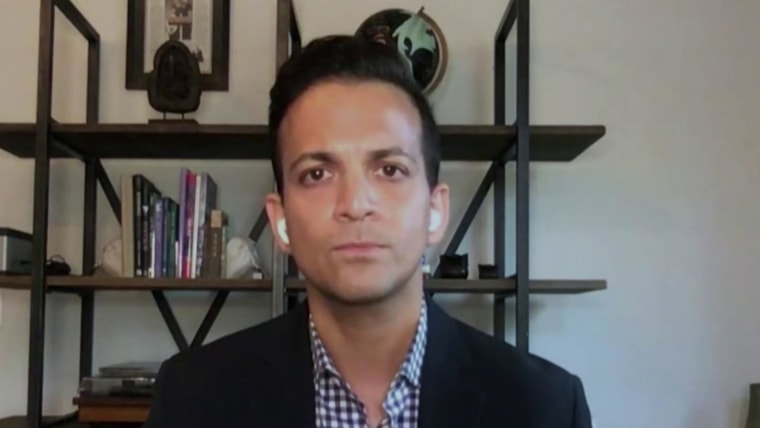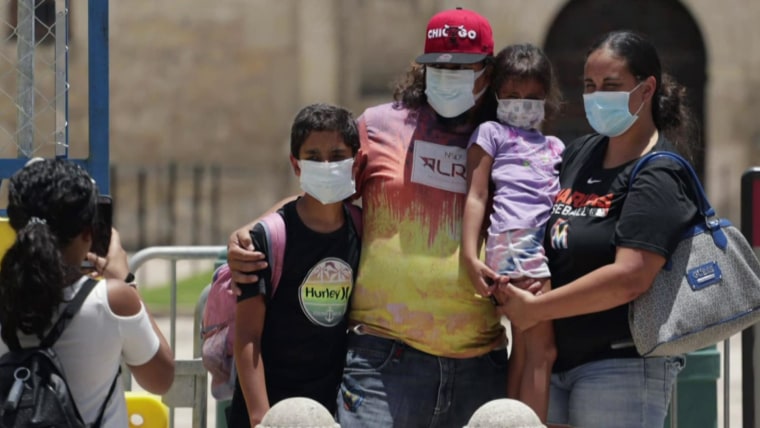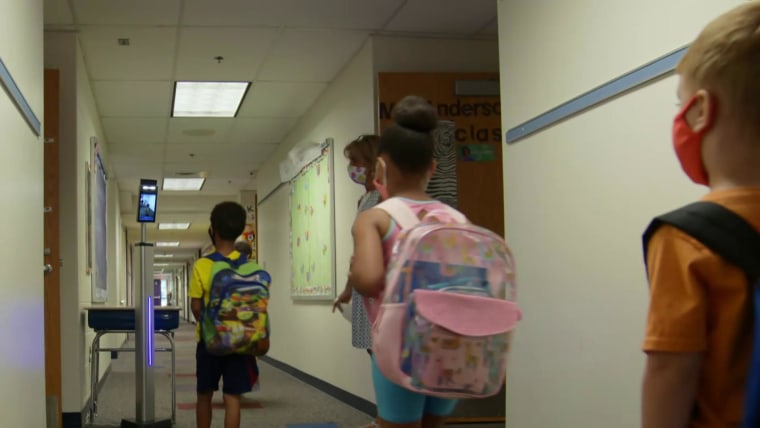Educators gathered Monday in demonstrations across the country addressing twin concerns of a safe and equitable school environment amid the COVID-19 pandemic and the nationwide reckoning around racial justice after the killing of George Floyd.
The demonstrations, held in dozens of cities, including Chicago, New York and Los Angeles, were part of the National Day of Resistance, organized by a coalition of teachers unions, social justice organizations and the Democratic Socialists of America. They took place in a combination of socially distant rallies and car caravans.
Educators who planned to participate in the day of action spoke to NBC News’ Social Newsgathering team in advance of the rallies. Many explained that their major concerns centered around the disproportionately negative impact COVID's new distance-learning modules had on students of color and low-income students, their concern about equitable access to online learning and, ultimately, concern about the lack of clarity in plans to reopen schools safely amid the COVID-19 pandemic.
Nina Hike, a high school chemistry teacher who works in the Chicago public school district, said she is nervous about her district’s plan for the new academic year, which she described as a hybrid model involving a combination of remote and in-person instruction. It's a plan teachers feel puts students and teachers at risk, and fails to take into account the challenges of equitably distributing resources to students in her district.
On July 17, the Chicago district released its plan, noting that it was rooted in science and in accordance with the guidance from the Centers for Disease Control and Prevention and the Illinois State Board of Education.
The plan states that schools will accommodate only 50 percent of the student population on any given day, and that teachers and students will undergo daily symptom and temperature checks. All teachers, staff and students will wear mandatory face coverings. Students will also be assigned to pods of approximately 15 students with a designated group of teachers. The district said that the pod model will reduce possible viral transmission and allow for rapid contact tracing in case of infections.
But Hike said she does not feel comfortable returning to the classroom in the midst of the pandemic. Chicago has seen over 61,000 cases of COVID-19 and nearly 2,800 deaths, according to data from the city published in August. Further, the city is heading in the wrong direction: the 7-day rolling average of COVID cases the last week of July was up 8 percent over the previous week.
“I don't feel safe because in the past, we've had issues with cleanliness inside the school. And to now know that, you know, the pandemic is raging … it’s just really hard for me to feel safe going back into the school,” she said. “What kind of learning do you think can take place if teachers and students are concerned about their lives?”
Cecily Myart-Cruz, the president of the United Teachers Los Angeles, the union representing Los Angeles' teachers, said she’s spoken with teachers in her district who are eager to be back in the classroom, but only when it’s demonstrably safe.
“If and when science and data supports it ... our educators want to be back,” she told NBC News. “There's not one educator that does not want to be back with their students, not one.”
Los Angeles and the state of California are currently seeing surges in COVID-19 cases. The state has reported more than 500,000 cases, the highest among any state in the country, and more than 9,300 deaths. Los Angeles County has reported more than 192,000 cases and more than 4,600 deaths since the pandemic began.
“There's no way, in good conscience, I could say I would support educators going back if the science and the data doesn't support it,” Myart-Cruz said.
The superintendent for the Los Angeles Unified School District agreed with the union’s push for distance learning due to the continued threat of COVID-19. On July 13, the district, in a joint statement with the San Diego Unified School District, announced it would begin the school year fully online and continue to plan for a return to in-person learning when public health conditions allowed.
But while a resumption of a distance learning model is the safest solution for both students and educators, teachers and experts are also worried about how remote learning will affect students, especially low-income students and students of color.
Students of color face a multitude of challenges when it comes to remote learning and are at a much higher risk of falling behind educationally than their white peers, according to the Urban Institute, a progressive think tank based in Washington, D.C. These risk factors include being linguistically isolated, in other words, living in a home where parents do not speak English and thus cannot support English-language education, living in poverty, and crowded conditions. Further, a lack of access to necessary technologies such as the internet and computers demonstrably distances these students from their peers.
This is what happened to Hike's students in Chicago; they struggled with distance learning because many did not have access to the internet or computers. Many resorted to using cellphones to complete their school work.
Further, people of color, who already face gaps in health care and housing access, have been disproportionately affected by the COVID-19 pandemic. While Black Americans make up only 13.4 percent of the U.S. population, they comprised 19.8 percent of COVID-19 cases and 22.1 percent of COVID-19 related deaths, according to the CDC. Hispanic/Latino Americans make up 18.5 percent of the U.S. population, yet comprise 31.8 percent of COVID-19 cases. The Chicago Public School district is 82.5 percent Black and Hispanic, according to data from the district.
“I think that the Black Lives Matter [movement], in conjunction with the pandemic, it kind of illuminated all of the inequalities that take place in the black community with all of the lack of resources, the disinvestment in communities of color, and then, now just the lack of resources even to get [an] education,” Hike said. “Nothing about being in a pandemic is normal. Nothing about dealing with racism is normal.”
Myart-Cruz echoed this sentiment, explaining that the COVID-19 pandemic has exacerbated divides between white students and students of color in the Los Angeles Unified School district. According to data from the 2019-2020 school year, the district is comprised of 90 percent students of color.
“We can't go back to the status quo and I think this is what this National Day of Resistance really begins to harken where we need to go,” she said. “We must move forward and we must have a new vision of how we do business inside of the classrooms and outside of them.”
Part of this vision includes more support systems for students, including mental health resources, more school nurses and ethnic studies programs, Myart-Cruz explained.
“We have a duty to be anti-racist educators,” she said. “Everywhere there's systemic, structural, institutional racism, it's our job to root it out from its very foundations. That means looking at the institutions, programs and policies to really break those, those barriers down. Our students are asking for that and it is incumbent upon us to do that work.”
"day" - Google News
August 04, 2020 at 03:03AM
https://ift.tt/3ig9yDN
Educators join National Day of Resistance to fight for safe and equitable schools - NBC News
"day" - Google News
https://ift.tt/3f7h3fo
https://ift.tt/2VYSiKW
Bagikan Berita Ini

















0 Response to "Educators join National Day of Resistance to fight for safe and equitable schools - NBC News"
Post a Comment